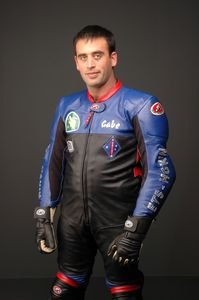Helimot One-Piece J-92 Custom Racing Suit
When was the last time you were treated to something really, really nice?
Maybe it was a $200 meal at a very good restaurant. Maybe it was an MV Agusta. From time to time, you just have to spoil yourself.
If you're in the mood, may I suggest a set of custom leathers?
Sure, you can buy a set of inexpensive roadracing leathers for under $400. They will even fit okay and protect you somewhat when the unfortunate but sadly inevitable high-speed get off happens. Off-the-rack leathers, even nice ones, are often ill-fitting. The less expensive ones seem to be made with marketing and cheap gimmicks as priorities instead of safety. They seldom make it past the first crash. And the high-end suits are almost as much - or more than - a custom-made suit anyway. Plus you have to pick a pattern that somebody else thinks is the epitome of high fashion.
If you've attended a trackday in California, you've probably seen a lot of riders wearing flashy, beautifully made suits with the "Helimot" logo on them. Often these are racer-types with plenty of sponsor's patches and the even more hallowed badges of high-speed scuff marks proving their credibility. A sponsored AMA racer can have any leathers he wants - so why do so many of them choose Helimot?
I was given an opportunity to order a Helimot suit, so I headed down to their San Jose factory to design my suit and get measured. Once there, I was greeted by an enthusiastic, professional staff inside the eclectic, cluttered showroom. Historic and damaged leathers from a myriad of famous racers were hung all around the walls, and the place was redolent with the wonderful smell of high-quality hides. It was like freebasing a new car.
Before Helmut greeted me, I had been poring over the pattern books. There are dozens of basic patterns to choose from, as well as examples of custom suits customers have ordered in the past. Some of the more wild designs include a Trompe l'oeil CHP officer's uniform, a Spiderman outfit, and a suit covered with glittering fish scales. As of yet, nobody has requested a giant squid suit.
I wanted a basic suit that would look good on a variety of motorcycles but would stand out from the crowd while looking much better than Sean's custom-made Alpinestars sausage skin. I selected the J-92 pattern, named after Jamie Hacking's 1992 design, with my name in swanky silver lettering. The font we picked is a standard Microsoft Word font we found: Helmut's craftspeople can trace and cut out just about any shape or pattern you want for graphics.
The next step was an intensive session of measuring, with Helmut putting his measuring tape on almost every possible part of my body. I tried to count how many measurements he took: I lost count after 20! I appreciate this kind of attention to detail, as leather needs to fit snugly to offer maximum protection, and my body doesn't follow the proportions and contours of your average guy's.
Just a few weeks later, there was a message on my answering machine telling me to come down and pick up my suit. I expected it to be nice; what I received was beyond my expectations.
Hanging proudly in the showroom was my suit. Every seam, every piece of leather was exactly as I had ordered it, and it looked much better in person than I could have ever imagined. Zipping into it for the first time was a bit of a struggle, but Helmut assured me it would loosen up and break in to my body's shape. Looking in the mirror, I saw a blue-clad, broad-shouldered superhero. Gabeman!
During my inaugural wearing of my new suit, Helmut proudly pointed out the features and innovations of his suits. The liner is fully removable and washable, and includes a nice stretch panel in the lower back. All the high-impact foam armor is removable, either through the liner or from zippered pockets in the knees. The back protector is cut to fit perfectly in the suit and provides cooling and extra rigidity with a raised central channel over the spine.
Racetrack specific features include the vented lower torso and aerodynamic racing hump. Helmut realizes the hump is mostly hype: "Once the GP racers have it, every suit has to have it - it's mostly for fashion." he laments. The added protective effect is negligible, especially when manufacturers use low-quality foam that breaks down quickly, and the improved aerodynamics apply only to the fastest of Moto GP racers, who draft each other at speeds in excess of 180 MPH. However, the Helimot Hump is special: the top is vented leather, creating a ram-air scoop that can be filled with ice to blow cool air down the rider's back. Would it work?
More by Gabe Ets-Hokin

































Comments
Join the conversation